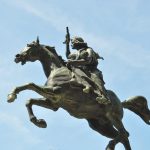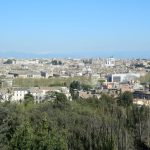150 YEARS OF THE NAZARETH SISTERS
In the footsteps of Blessed Frances Siedliska in Rome (7)
Sr. M. Beata Rudzińska, CSFN

People of the Risorgimento
The Risorgimento has its heroes. Their monuments are huge, and Roman streets, squares, metro stations are named after them… Walking around Rome, it is worth knowing at least a little bit about who they were, especially since they were, after all, contemporaries of Francis Siedliska.
First of all, Victor Emmanuel II (Vittorio Emanuele di Savoia-Carignano) – one of the four “fathers of the Fatherland,” reigning in the Kingdom of Sardinia, and since 1861 the first king of united Italy. It was to him that the already mentioned huge building in the Venice Square – Vittoriano – was dedicated, for which the entire Renaissance quarter was demolished. We will someday devote even more attention to this monument, as well as the entire Venice Square, because it is connected to the history of the Nazareth Sisters in Rome. The new street leading from the Tiber River to Piazza Venezia also bears his name, or even the metro station where one gets off to walk to the Nazareth Sisters’ motherhouse in via Machiavelli. Even before the unification of Italy and thereafter, he was immensely popular as Italy’s first king. Before his death, Pius IX removed the excommunication imposed on him for occupying the Church State. He died on January 9, 1878, and the funeral ceremonies in the Pantheon (where he is buried) were a grand display in his honor. Their description can be found, among others, in Edmund Amicis’ well-known book “The Heart”.
A month later, his “opponent” Pius IX died. He wanted to be buried outside the walls of Rome, in the Basilica of St. Lawrence. His body was transported under cover of darkness, but even so, the ominous behavior and outcries of Italian liberals were not avoided.
As popular as King Victor Emanuel was Giuseppe Garibaldi – a revolutionist and politician, a Mason, an opponent of the papacy and all those threatening Italian unity. His biography would be enough for several people. It is to him that the famous cry “O Roma o morte” (Rome or death) uttered at the start of the conquest of Rome in 1862 belongs. This was not his first expedition to the Eternal City. He had already occupied it in 1849, establishing the Roman Republic, but had to withdraw when French troops came to the relief of the Pope. His monumental figure on horseback, with his head facing the Vatican, can be seen at the top of Gianicolo, from where tourists enjoy a beautiful panorama of Rome. A few dozen meters away, also on horseback, is a memorial of Anita Garibaldi, who fought by her husband’s side. The entire hill is full of monuments and busts of the heroes of the 1849 battles, as the hardest of the battles was fought here.
Those living in Rome are also familiar with names such as Cavour and Mazzini. Camillo Cavour was an Italian politician, prime minister and foreign affairs minister appointed by King Victor Emmanuel. He contributed greatly to the unification of Italy, but also, as a Mason, to reducing the influence of the Church in society. At the time of his death (1862), 70 bishops, several hundred priests and 12,000 religious sisters and brothers had been removed from their parishes and religious houses.
And the last of the “fathers of the Fatherland” – Giuseppe Mazzini, Italian lawyer and revolutionist, Mason, who devoted his entire life to the idea of liberating the peoples of Europe, fought alongside Garibaldi.
The Risorgimento also had its own eulogist. This was the composer Giuseppe Verdi, known to all. His works, full of patriotic symbolism, accompanied the fighters for unification, and the well-known piece Va, pensiero from the opera Nabucco soon after its premiere became the unofficial national anthem of the Italians.
Despite the often hostile attitude of Italy’s new rulers toward the Church, no religious buildings, names or symbols were removed from Rome. That is why today, walking in the footsteps of Francis Siedliska, we walk not only along the streets of Cavour or Garibaldi, but the many saints and popes who lived here. For me, Rome is still ancient, imperial, papal, not just modern…
In the next episode, we will return again to Piazza Venezia to begin the recounting of the third story that began there – the story of the Congregation of the Holy Family of Nazareth. However, that will be covered next month.
Pictures:
Monuments of Giuseppe and Anita Garibaldi – https://www.rzym.it/promenada-gianicolo
Vittoriano, Panorama from Ganicolo – Sr. Anita Jach
Square and the monument of Camillo Cavour – https://romah24.com





